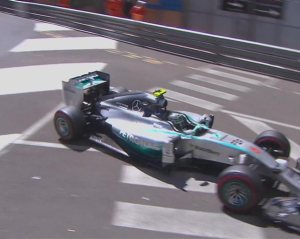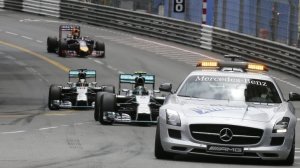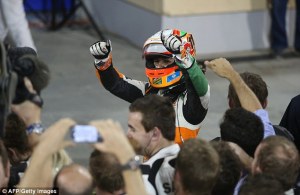Having grabbed the lead of the world drivers’ championship with victory in Barcelona – his fourth straight win – Lewis Hamilton promptly surrendered it back to Nico Rosberg, who took a lights to flag victory in Monaco. All quite straightforward, you might think, but that would be a massive over simplification.
The tensions between the two Mercedes team-mates, which had been bubbling away under the surface prior to Monaco, finally erupted this weekend. The battle between the two drivers has been close all season and, going in to the final Q3 run in qualifying the pair were separated by less than six hundredths of a second. But it was what happened on that final qualifying run that has ramped up the tension at Mercedes to such an extent that come the podium in Monaco, the two team-mates couldn’t even look at each other, let alone congratulate each other on another 1, 2 finish.
The flashpoint was the mistake from Nico Rosberg on Saturday, which saw him lock up at Mirabeau and go straight on down the escape road. The error ruined Rosberg’s final run and opened the door for Hamilton, who was half a lap behind him and going quickly. However, the problem for Hamilton was that Rosberg’s error also brought out yellow flags; yellow flags that Rosberg guaranteed would continue to be waved as he reversed backwards onto the track.
There was talk that Rosberg deliberately went off to guarantee himself pole position, but I don’t agree that was the case. Indeed, the stewards didn’t think so, either, having examined the TV footage and telemetry as part of their post-qualifying investigation into the issue. The issue for Mercedes is, though, that many in the paddock, including, crucially, Lewis Hamilton thought otherwise. Hamilton’s mood would not have been helped by Rosberg’s pole celebrations, which I would say were over the top, particularly so given the circumstances.
It’s in a situation like this where the media like to stir the pot. Hamilton fell into the trap of saying that he’d deal with the situation like Senna in a post-qualifying interview, which ramped up the tension another notch. The Prost/Senna comparisons, already prevalent in the media, were brought out again. All the talk was of a potential incident at turn one.
As it happened there was no such incident come race day. Rosberg got off the line brilliantly, unlike in other races this season, and led Hamilton and the rest of the field into turn one. Given the nature of the Monaco track – tight, twisty, and with limited opportunities to overtake – the start was the first of two big chances for Hamilton to overtake Rosberg; one which he couldn’t take.
The second chance would come through strategy, with Hamilton hoping to use the single pit stop that both drivers were scheduled to make to his advantage. Unfortunately for him, the second of the two safety car periods, caused after Adrian Sutil crashed his Sauber heavily coming out of the tunnel, fell in the ‘window’ for making that pit stop.
We heard over the radio that Hamilton was irked that he hadn’t stopped immediately, before the deployment of the safety car. Instead Mercedes took the safe option and stopped both drivers on the same lap, following the deployment of the safety car. That decision, while completely understandable, meant that Hamilton had to wave goodbye to his second big chance to overtake his German team-mate.
With Hamilton questioning the decision and his frustration levels rising, he resumed the fight after the safety car in the wrong frame of mind. Not that it mattered at the time, though. Hamilton could never quite get close enough to Rosberg to attempt to pass, even when the latter was forced to save fuel for several laps. The fight was over long before Hamilton suddenly and alarmingly dropped back several seconds from Rosberg after dirt became lodged in his eye.
In the end, Rosberg won the race comfortably, by over nine seconds from Hamilton who did well to hold off the hard charging Daniel Ricciardo who took third for Red Bull Racing. Once he’s had a chance to calm down and reflect on the situation Hamilton may feel differently, but he was certainly not happy post-race. The body language between the two team-mates at Mercedes suggests that they’re on the verge of meltdown; a consequence of the team’s decision to let their drivers race each other on an equal footing.
While meltdown might be on the cards at Mercedes, there was delight for one of Formula 1’s smaller teams. Marussia, through 24-year-old Frenchman Jules Bianchi, finally scored their first point in Formula 1 in their fifth year in the sport. Bianchi’s ninth place finish (he actually crossed the line eighth, but had to take a five second penalty) resulted in the Banbury-based team scoring not one, but two world championship points. This means that they’re now ahead not only of fierce rivals Caterham, but also Sauber in the world constructors’ championship. A massive achievement.
There’s no chance of them, or anyone else for that matter, overhauling Mercedes, though. That is unless the Brackley-based squad shoot themselves in the foot by going into a full-scale meltdown. The Silver Arrows have now amassed 240 world championship points. Their nearest rival, Red Bull Racing have yet to break into three figures, thanks, in part, to an early retirement for Sebastian Vettel in Monaco.
All eyes will continue to be on Mercedes as we head to Canada in two weeks’ time. Lewis Hamilton will be desperate to reassert his authority, and retake the championship lead, in Montreal; a track he loves and has had great success at in the past. Nico Rosberg will be equally keen to ensure that the momentum remains with him. The battle between the Mercedes team-mates looks set to be a season long one.















